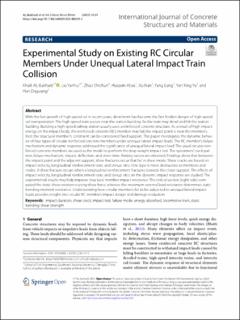| dc.contributor.author | AL-Bukhaiti, Khalil | |
| dc.contributor.author | Yanhui, Liu | |
| dc.contributor.author | Shichun, Zhao | |
| dc.contributor.author | Abas, Hussein | |
| dc.contributor.author | Nan, Xu | |
| dc.contributor.author | Lang, Yang | |
| dc.contributor.author | Yu, Yan Xing | |
| dc.contributor.author | Han, Daguang | |
| dc.date.accessioned | 2023-02-10T13:22:39Z | |
| dc.date.available | 2023-02-10T13:22:39Z | |
| dc.date.created | 2022-08-17T10:40:16Z | |
| dc.date.issued | 2022-07-21 | |
| dc.identifier.citation | International Journal of Concrete Structures and Materials. 2022, 16 (1), . | en_US |
| dc.identifier.issn | 1976-0485 | |
| dc.identifier.issn | 2234-1315 | |
| dc.identifier.uri | https://hdl.handle.net/11250/3050053 | |
| dc.description.abstract | With the fast growth of high-speed rail in recent years, derailment has become the frst hidden danger of high-speed rail transportation. The high-speed train passes near the station building. So the train may derail and hit the station building. Building a high-speed railway station usually uses a reinforced concrete structure. As a result of high impact energy on the impact body, the reinforced concrete (RC) member may fail; the impact point is near the member’s foot; the structural member’s constraint can be considered fxed support. This paper investigates the dynamic behav‑ ior of four types of circular reinforced concrete members under unequal lateral impact loads. The RC member’s failure mechanism and dynamic response addressed the signifcance of unequal lateral impact load. The usual circular rein‑ forced concrete members are used as the model to perform the drop-weight impact test. The specimens’ crack pat‑ tern, failure mechanism, impact, defection, and strain time–history curves are obtained. Findings show that between the impact point and the adjacent support, shear fractures occur that fail in shear mode. Shear cracks are based on impact velocity, longitudinal reinforcement ratio, and stirrup ratio. One type is more destructive to members and nodes. A shear fracture occurs when a longitudinal reinforcement fractures towards the closer support. The efects of impact velocity, longitudinal reinforcement ratio, and stirrup ratio on the dynamic impact response are studied. The experimental results may help improve structural member impact resistance. The critical section (right side) com‑ puted the static shear resistance using shear force, whereas the maximum external load resistance determines static bending moment resistance. Understanding how circular members fail to be subjected to unequal lateral impact loads provides insight into circular RC members’ impact design and damage evaluation. | en_US |
| dc.language.iso | eng | en_US |
| dc.publisher | SpringerOpen | en_US |
| dc.relation.ispartofseries | International Journal of Concrete Structures and Materials;16, Article number: 39 (2022) | |
| dc.rights | Navngivelse 4.0 Internasjonal | * |
| dc.rights.uri | http://creativecommons.org/licenses/by/4.0/deed.no | * |
| dc.subject | Impact duration | en_US |
| dc.subject | Shear crack | en_US |
| dc.subject | Impact tests | en_US |
| dc.subject | Failure mode | en_US |
| dc.subject | Absorbed energy | en_US |
| dc.subject | Trains | en_US |
| dc.subject | Static bending | en_US |
| dc.title | Experimental Study on Existing RC Circular Members Under Unequal Lateral Impact Train Collision | en_US |
| dc.type | Peer reviewed | en_US |
| dc.type | Journal article | en_US |
| dc.description.version | publishedVersion | en_US |
| dc.rights.holder | © The Author(s) 2022 | en_US |
| dc.source.articlenumber | 39 | en_US |
| cristin.ispublished | true | |
| cristin.fulltext | original | |
| cristin.qualitycode | 1 | |
| dc.identifier.doi | https://doi.org/10.1186/s40069-022-00529-5 | |
| dc.identifier.cristin | 2043735 | |
| dc.source.journal | International Journal of Concrete Structures and Materials | en_US |
| dc.source.volume | 16 | en_US |
| dc.source.issue | 1 | en_US |
| dc.source.pagenumber | 21 | en_US |

